Dive With Tiger Sharks in Fiji
What lurks in the mind of a 13-foot tiger shark? The expert shark handlers and resident marine biologist at Fiji’s Beqa Lagoon Resort might just be the best people to tell you.
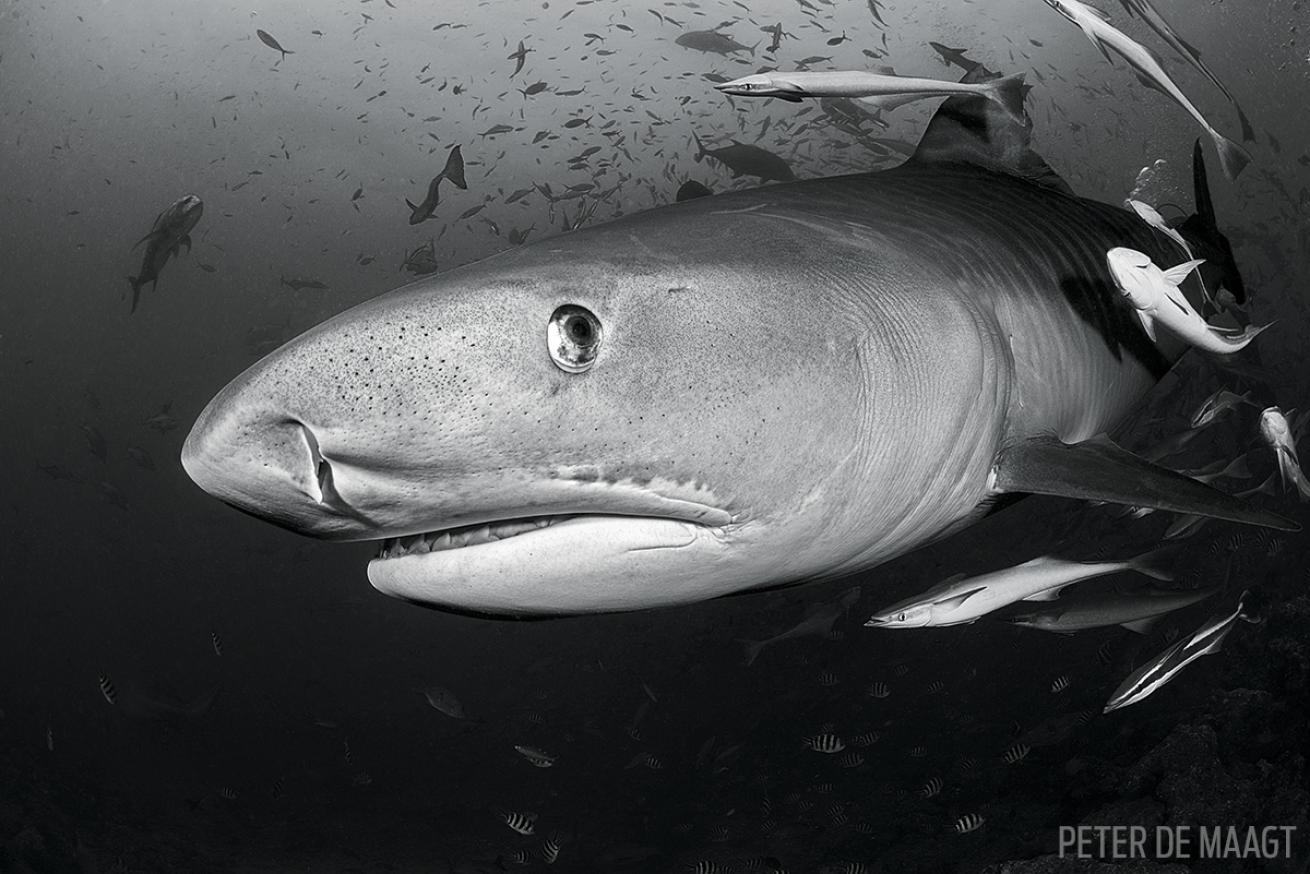
Peter De MaagtWhat lurks in the mind of a 13-foot tiger shark?
As soon as we arrive at Cathedral, the shark dive site where Beqa Lagoon Resort lures tigers and more, I am viciously attacked. For what turns out to be the entire dive, I am harried, harassed and nibbled — by an adorable 4-inch threespot dascyllus who either wants to kill me or take me home to mother. It’s a ballsy display from a tiny creature that surely knows what’s about to happen here.
Twenty divers kneel 65 feet down in Beqa Passage between Fiji’s big island, Viti Levu, and Beqa (pronounced m-BENG-a), waiting for the start of what might be the most thrilling shark dive in the world. My little friend represents a sliver of a fraction of the biomass exploding into action all around us — hundreds of species from remoras to chromis, demoiselles, barracuda, butterflyfish, mackerel, red-toothed triggers, huge bumphead wrasse, malabar grouper and giant trevally, all swirling together in a sandy maelstrom.
And then come the sharks. First to arrive is a tawny nurse shark so large, I think it must be some other kind of animal.
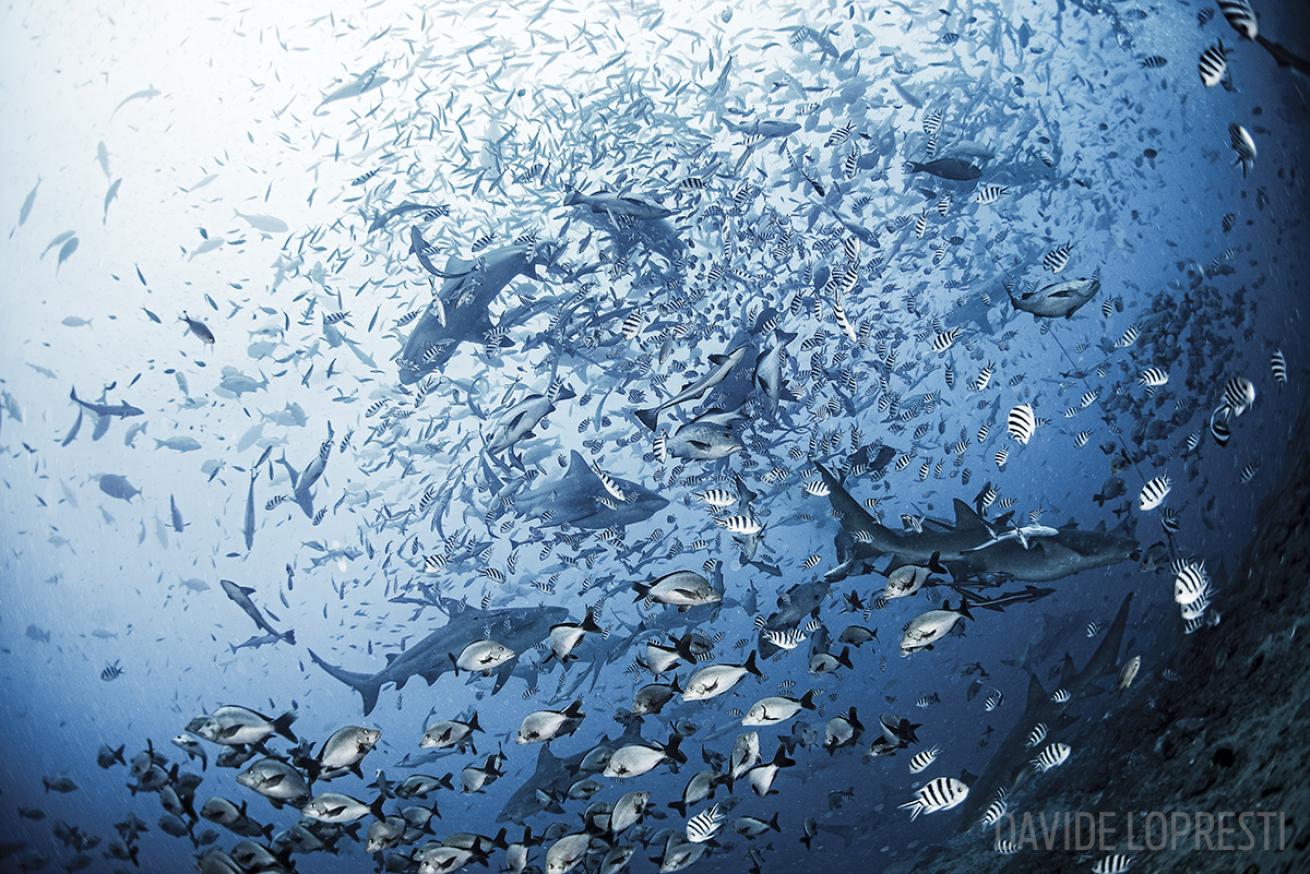
Davide LoprestiProvisioned dives in Beqa Lagoon attract a host of animals, along with sharks.
Next are the bulls, 10 of them swerving in and out of the scene in a way that seems choreographed. It’s mesmerizing.
And then, the lady we’ve all been waiting for, and she’s not alone. The bulky, half-ton tiger dominates the action, cruising slowly up and down the line of divers right over our heads, having a good look at each of us, for 15 or 20 minutes. There’s intelligence in those eyes, and curiosity. She’s followed by another female and a small male, who don’t come as close.
At one point our leading lady becomes very interested in a photographer at the end of the line, lightly mouthing a fin and nearly a knee, until a handler leans in and gives the tiger a gentle shove with his long shepherd’s crook staff, which she obligingly takes and drags a few feet into the arena, where she drops it.
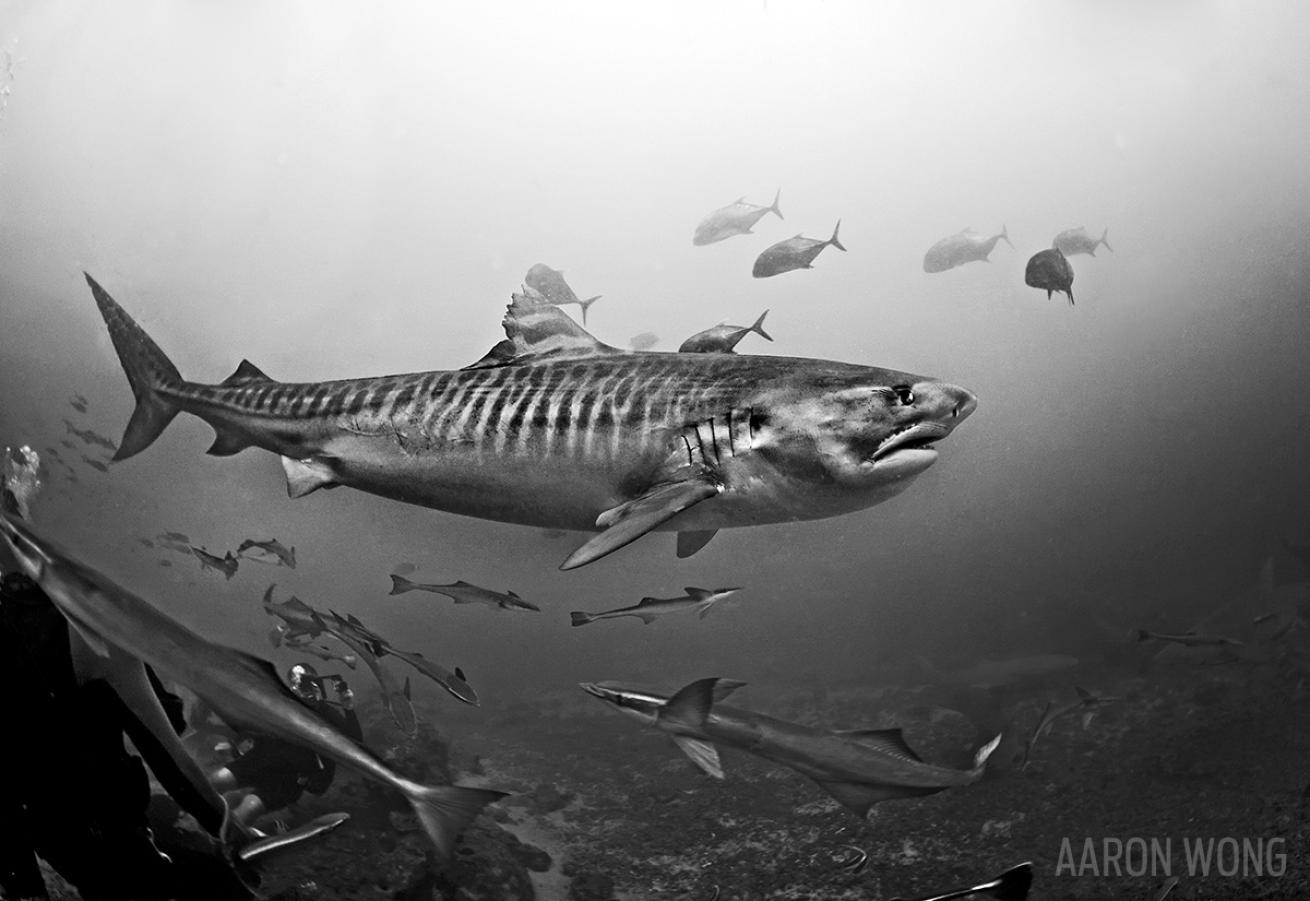
Aaron WongAn awe-inspiring young tiger.
It looks like a game, with all the players very comfortable with one another, but the more we watch the videos — over and over for the rest of the week — the less clear it is what we’re looking at, a curious animal or a predator about to blow the lid off the whole idea that this is controlled in any way.
Apparently what’s on the mind of a tiger shark is somewhat in the eye of the beholder, and therein lies the reason that shark diving – provisioned or otherwise — is both the fastest-growing segment of the dive industry and its most controversial.
MEN IN BLACK
Modesty, self-control and good manners are essential to the well-bred Fijian. But don’t mistake that for softness. Men and women here exude a vitality that leaves you little doubt they could enforce these norms should a visitor, entranced by this hospitably laid-back Eden, forget their custom
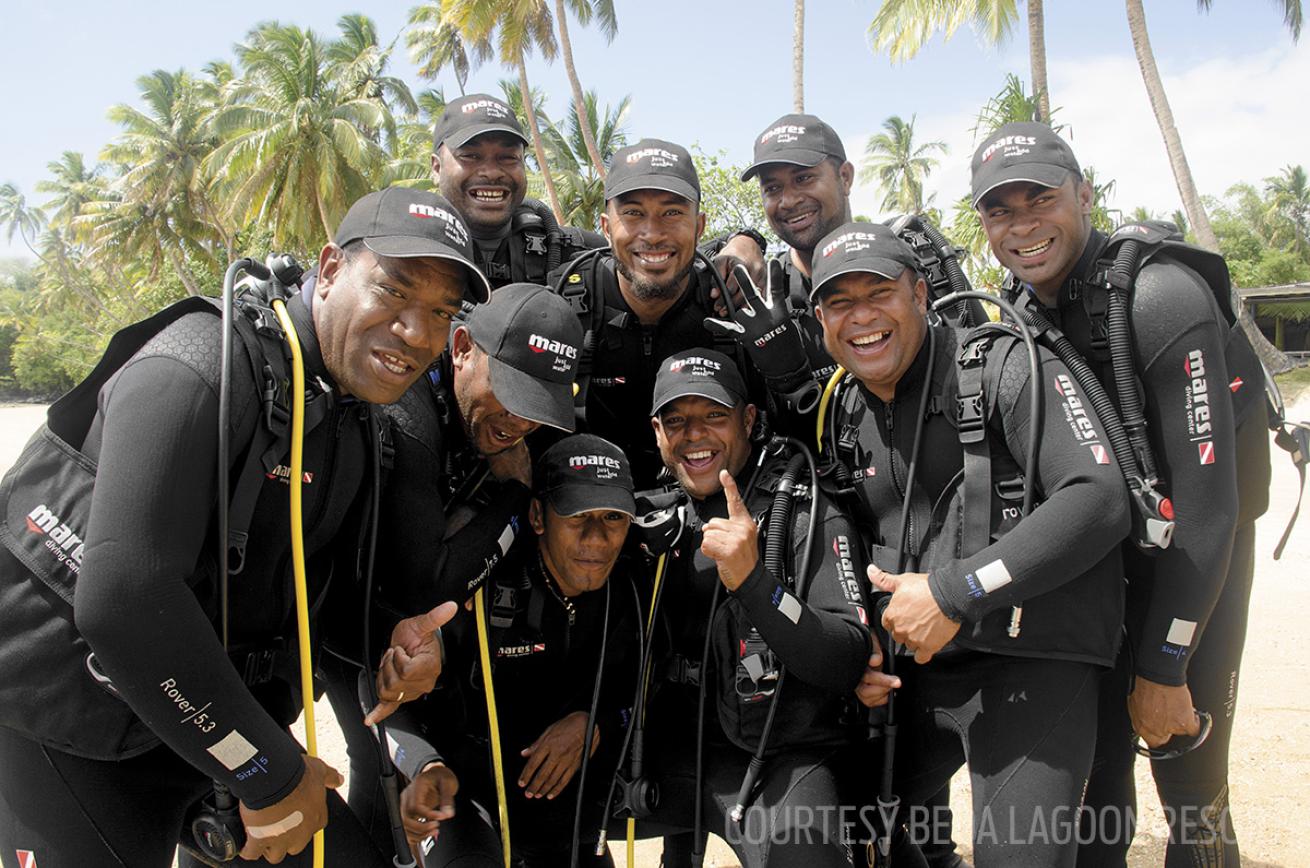
Courtesy Beqa Lagoon ResortThe shark handlers of Beqa Lagoon.
It’s evident in the highly trained shark handlers of Beqa Lagoon Resort — there are rules, for sharks and divers, and bad behavior is not tolerated. Each shark species has its own pecking order, but all seem to know who’s the boss: It’s the men in black suits, not gray.
BLR goes to lengths to make sure divers who come to this South Pacific island for the soft corals and astonishing array of anemones and their resident fishes as much as for the sharks understand what’s happening here. You get the feeling the handlers are protecting the sharks more than the divers, and there’s a reason for that.
Custom and ritual still matter in Fiji, nowhere more so than with sharks, traditionally revered as gods. On certain of Fiji’s islands, including Beqa, there’s a belief that only those who have offended a chief or broken a taboo can be bitten. “You can see the behavior between the local handlers and sharks,” says BLR’s resident marine biologist Sefano Katz. “There’s a communication, and it’s mutual.”
Brandon Paige — owner of Aqua-Trek, a dive operation based in nearby Pacific Harbour that serves resorts like the über-luxurious Nanuku Auberge Resort — helped BLR start its tiger shark dive, partly to relieve crowding on the lagoon’s existing shark dives, popular for decades.
“Those Beqa boys know what they’re doing. I’m glad they started it,” Paige says. Aqua-Trek’s shark dives take place at a site called the Bistro, not far from Cathedral, and focus on bulls. Paige promotes shark diving “to destroy the myths” about bulls in particular and sharks in general; he says provisioned shark diving also has helped improve fish density on local reefs.
Katz gives a special mandatory briefing for BLR’s shark dives that fills 17 pages of my small field notebook. About 20 eager divers — part of a 50-member group from Island Hoppers Scuba, a Nashville, Tennessee, dive shop — absorb every word.
Katz describes the drill: A metal box on the bottom, in front of a knee-high rock wall, will be provisioned with fish heads by the dive team. Huge trash bin-size receptacles of scraps had been taken down that morning (“the stimulus of smell,” Katz explains); no hand-feeding is allowed.
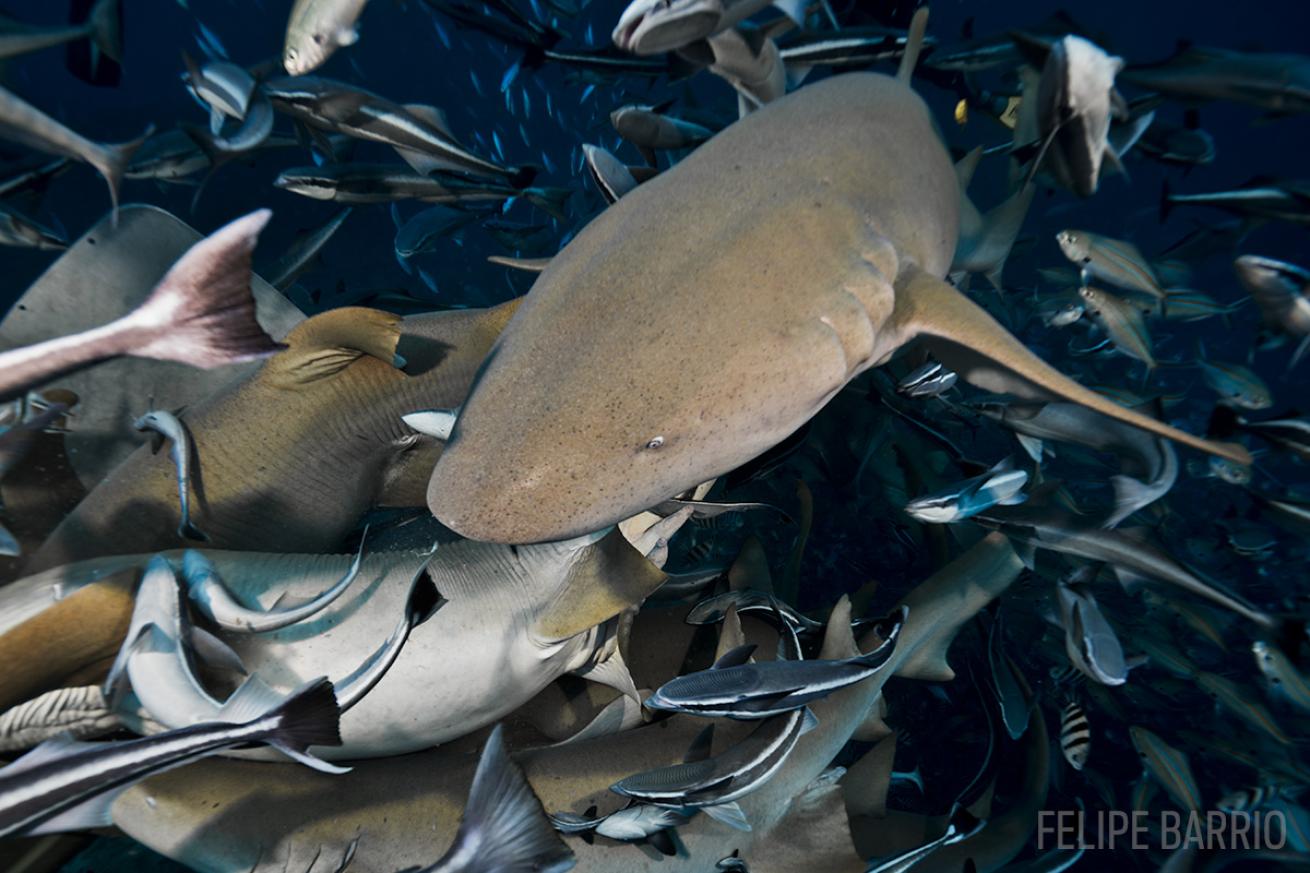
Felipe Barrio/Ultima Frontera PhotoNurse sharks are also frequently spotted during the feed.
Katz details the sharks he expects will be present: whitetip and blacktip reef sharks, the smallest here — “little gangsters, those guys,” Katz says fondly of three or four regulars. Small gray reef sharks also are common, identifiable by their chromelike shimmer and large eyes. Five sicklefin lemons, with pointier fins than the Caribbean variety, are regulars. A dozen large tawny nurse sharks also are associated with the site.
The most exciting sharks, and the most prominent in Fiji, Katz says, are the bulls, found everywhere in coastal waters here. The Cathedral attracts from five to 30 bulls per dive; as many as 400 are resident in enormous Beqa Lagoon, which covers more than 150 square miles.
But as thrilling as bulls are, they’re not the shark most divers are hoping to see. The biggest predatory fish here — 18 feet is not uncommon — are the tiger sharks this dive was built to lure. More than 30 of these elusive sharks have been associated with the site over about five months preceding our late-August dive. Typically two to three might show up per dive — once as many as five, Katz says. Solitary and nomadic, they are believed to routinely travel up to 1,000 miles; speculation is that the midpassage Cathedral site might be located on or near a tiger shark highway or hangout.
“Pay attention to the divemasters,” Katz reminds us as we head for the beach, where launches ferry us to dive boats moored in the resort’s small bay. “There’s something very special about the communication between tigers and ourselves.”
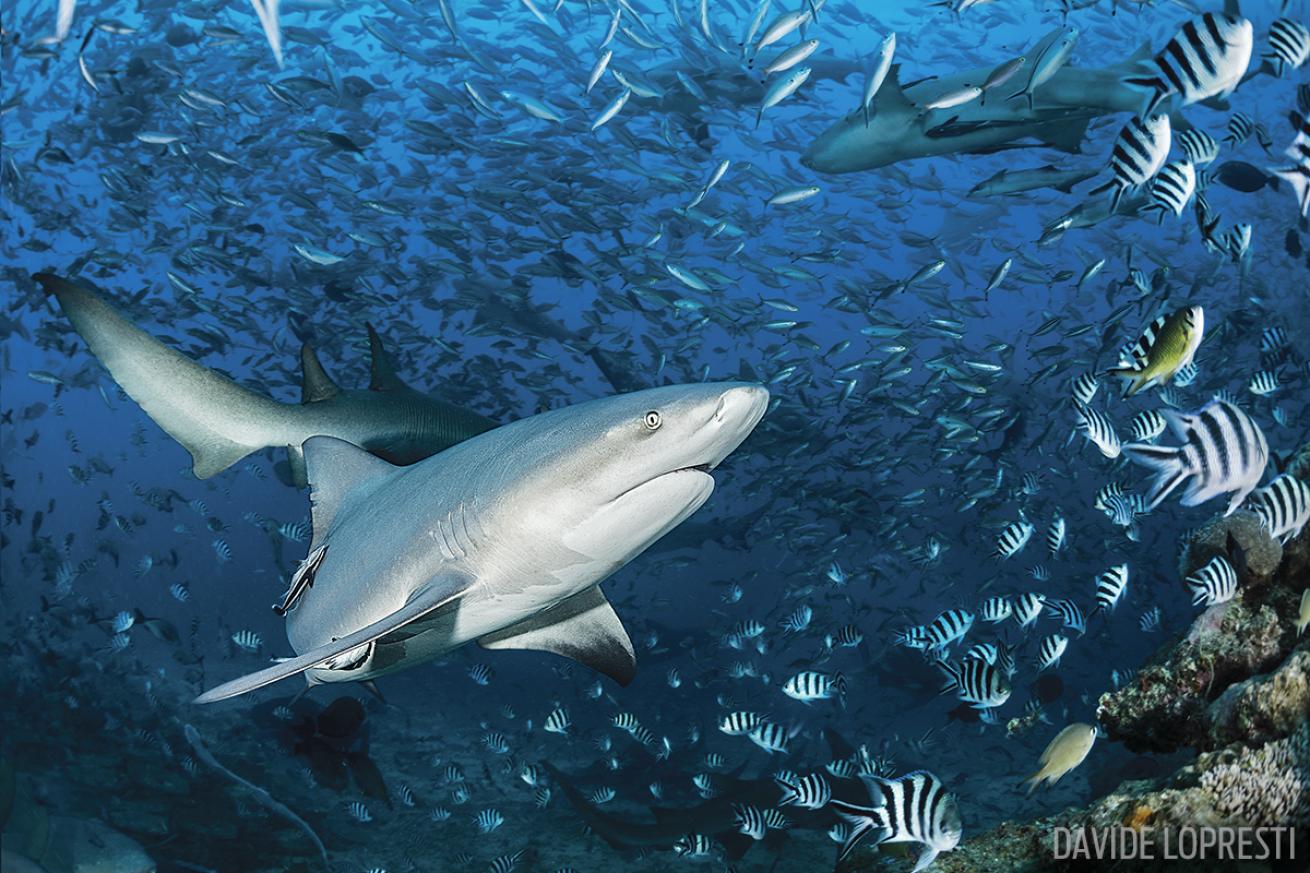
David LoprestiIt may be billed as a tiger shark dive, but bulls are reliably thrilling attendees too.
FUTURE SHARK
“Sharks and Fiji go way back,” Katz says later at his weekly intro to shark biology and sociology. It’s happy hour at the dining bure, the warm heart of this 25-room all-inclusive resort, and a small audience has gathered to listen and learn.
Sharks haven’t changed much over the eons. “We’re swimming with living fossils,” Katz says. And yet today, “things are changing in the marine environment in ways that are very unpleasant for sharks.”
Many shark species — there are at least 500 — survived Earth’s early mass-extinction events; some of them certainly will survive the so-called sixth extinction, underway now and powered at least in part by humans, many scientists believe. So why “conserve” sharks? For one thing, they are among the oldest animals on the planet, found in every environment and depth.
Proof, Katz says, that they’re just not that into us.
“Anytime you go in the ocean, there’s a shark nearby,” Katz says. “If they wanted to predate humans, there’s no way we’d get away. There’d be millions of deaths a year. We’re not on their menu.”
What role does provisioned shark diving play in changing the fateful course we appear to be on?
Adherents believe it’s worth the risks to expose humans to what is about to be lost. Few studies have been done on shark provisioning; some seem to suggest that, in well managed programs, the effect on sharks is short-term and limited to feed duration. A potentially bigger issue, and one that requires more study, is operator management of divers who often don’t govern themselves well when things don’t go according to plan, creating sometimes dire consequences for the sharks who have been lured to the site.
That tension between the need for more data and concern for the effect on sharks is something Rick MacPherson — a conservation biologist and founder of sustainablesharkdiving.com, a sort of TripAdvisor for shark diving — deals with every day.
“In practical conservation work, particularly the conservation of globally threatened species such as sharks, we don’t have the luxury of waiting for yet more data or for a controversy to be resolved in order to act. That means being willing to employ pragmatic, sometimes imperfect, approaches to see what might work,” MacPherson says. “The opportunity to shift opinions about sharks through provisioned-shark-dive tourism represents one of those pragmatic solutions. But we need to be honest and open about the inherent risks in feeding wildlife. Otherwise, decades of work in shifting public perception of sharks can be undone in a single, avoidable misstep.”
Scientists tend to agree that sharks are being depleted quicker than they can replenish their populations. But there’s not much data on the effects of large-scale removal of predators from the marine environment. Eliminating vast numbers of sharks from the oceans — 100 million annually is an oft-cited figure that probably doesn’t sufficiently count by catch and unrecorded catches — “has cascading effects down the food web,” Katz says. “Something’s going to happen down the line.”
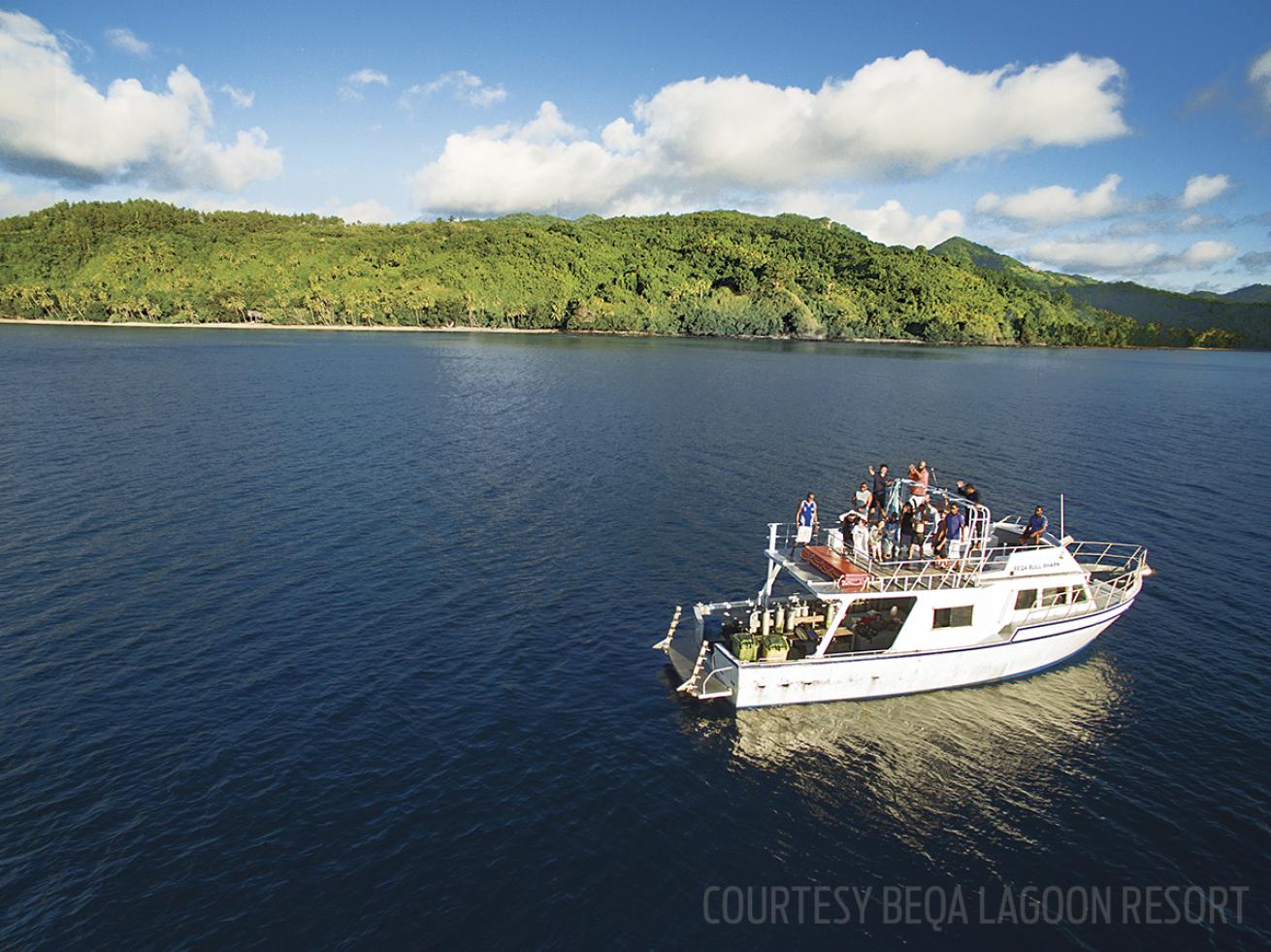
Courtesy Beqa Lagoon ResortBeqa Lagoon Resort boat.
FIJI FAREWELL
As the week goes on, more eager divers sign up for BLR’s shark dives, some of them repeaters who just can’t get enough. We don’t have as many tigers, but they are hardly missed. Where Galeocerdo cuvier seemed to perform a stately minuet, the 20 or so bulls who dominate later dives are more like flamenco dancers — all sharp staccato movements, and much, much faster, but no less beautiful.
How to come down from a high like that? In Fiji, of course, with song. Returning from a sunset snorkel on BLR’s gorgeous house reef, I hear the strains of an island choir floating from the dining bure out across the verdant lawn, where the first stars are beginning to twinkle high overhead. I don’t need to know the words to understand the offering of loving gratitude for this place, this life.
The next morning I reluctantly head for the launch back to Pacific Harbour, and suddenly realize there is staff gathering on the sands. They begin a beautiful lament, and this time I ask what the words mean. It’s a love song to Beqa Lagoon, and a farewell. Tears spring to my eyes as one woman steps forward and, taking the hibiscus from her hair, places it in mine. “You must throw it on the water as you leave,” she says. “If it comes back, you will too.”
I did, and I will. I hope the shark gods are listening.
NEED TO KNOW
When to Go Beqa Lagoon Resort is a year-round destination. Warm season is November to April; cooler temps last from May to October.
Dive Conditions Dive sites range from 15 to 100 feet. Water temps range from 75 to 84 degrees F; a 3 mm or 5 mm suit is good. Visibility can be hundreds of feet; rain and wind can shorten that. Currents are stronger near the outside edges of the lagoon.
Operators Beqa Lagoon Resort is a beautiful island dive resort that’s also great for snorkelers or families traveling with nondivers. It has 25 bures, or cottage rooms, ranging from honeymoon- worthy beachfront villas with plunge pools to garden bures arranged around a koi pond to two bedroom suites that are great for groups. Meals take place in the soaring thatched bure that faces an infinity pool and the beach, adjacent to a dive shop where your gear is stored. Kayaks, paddleboards and other watersports are available, as well as island hikes and village visits.
Travel Tip Fiji Airways offers direct flights from Los Angeles, San Francisco and Honolulu. Take baggage rules seriously: They are enforced. Ask BLR about its Fiji Airways “Dive Pack,” which gets you an extra checked bag for $100 roundtrip. International flights come into Nadi; from there it’s a two- to three hour ride to Pacific Harbour, where you’ll pick up a 45-minute launch to Beqa Island.
Splurge For couples who want a romantic getaway before or after a group dive trip, unwind at Pacific Harbour’s boutique Nanuku Auberge Resort. Its enormous villas are the ultimate in luxury, and the dining is five-star, wrapped in the loving reverence for tradition that Nanuku raises to an art form.
Price Tag A seven night BLR stay with three meals daily, round-trip transfers and 10 two-tank dives (not including the shark dive) starts at $1,799 per person, double occupancy.










